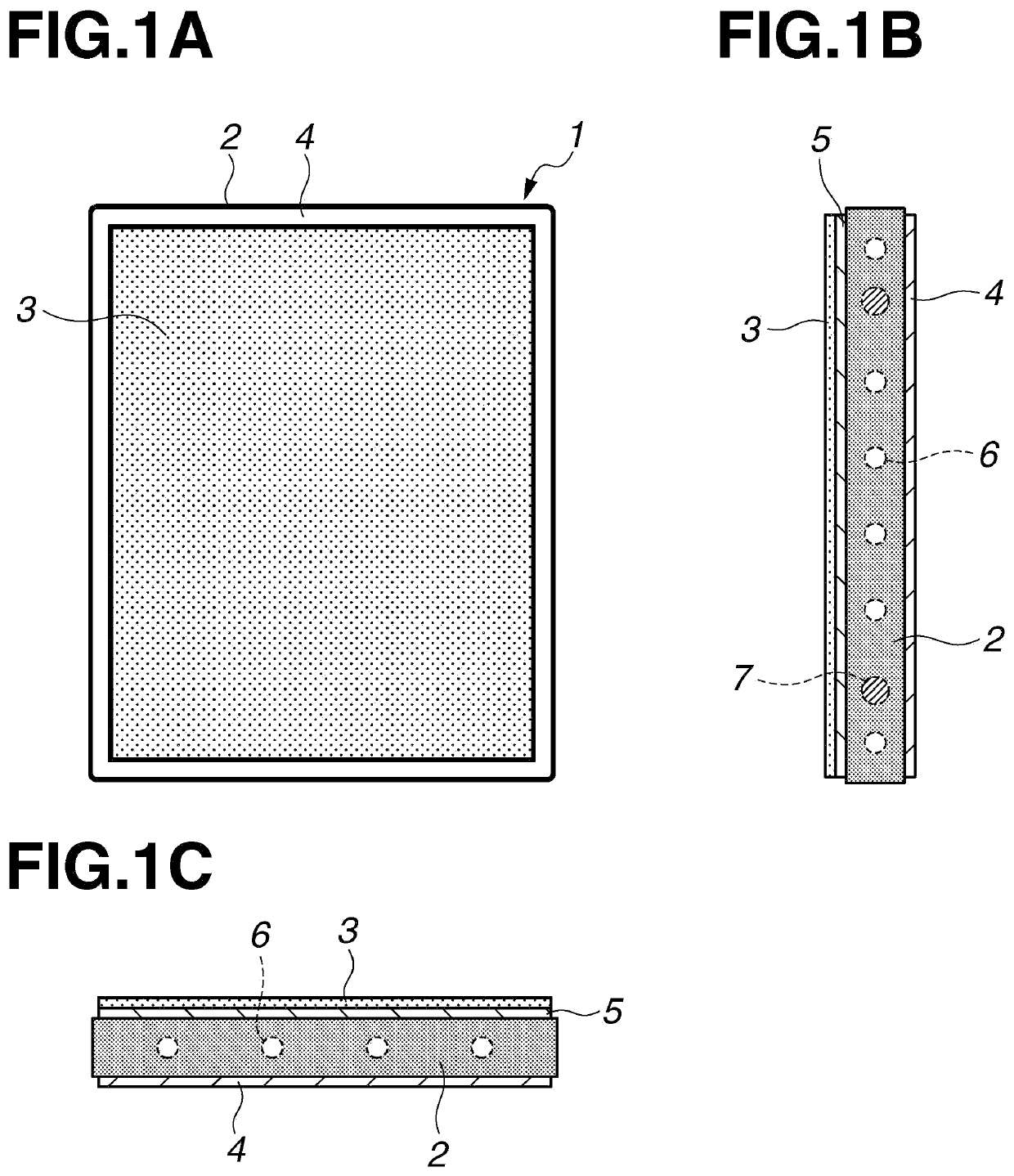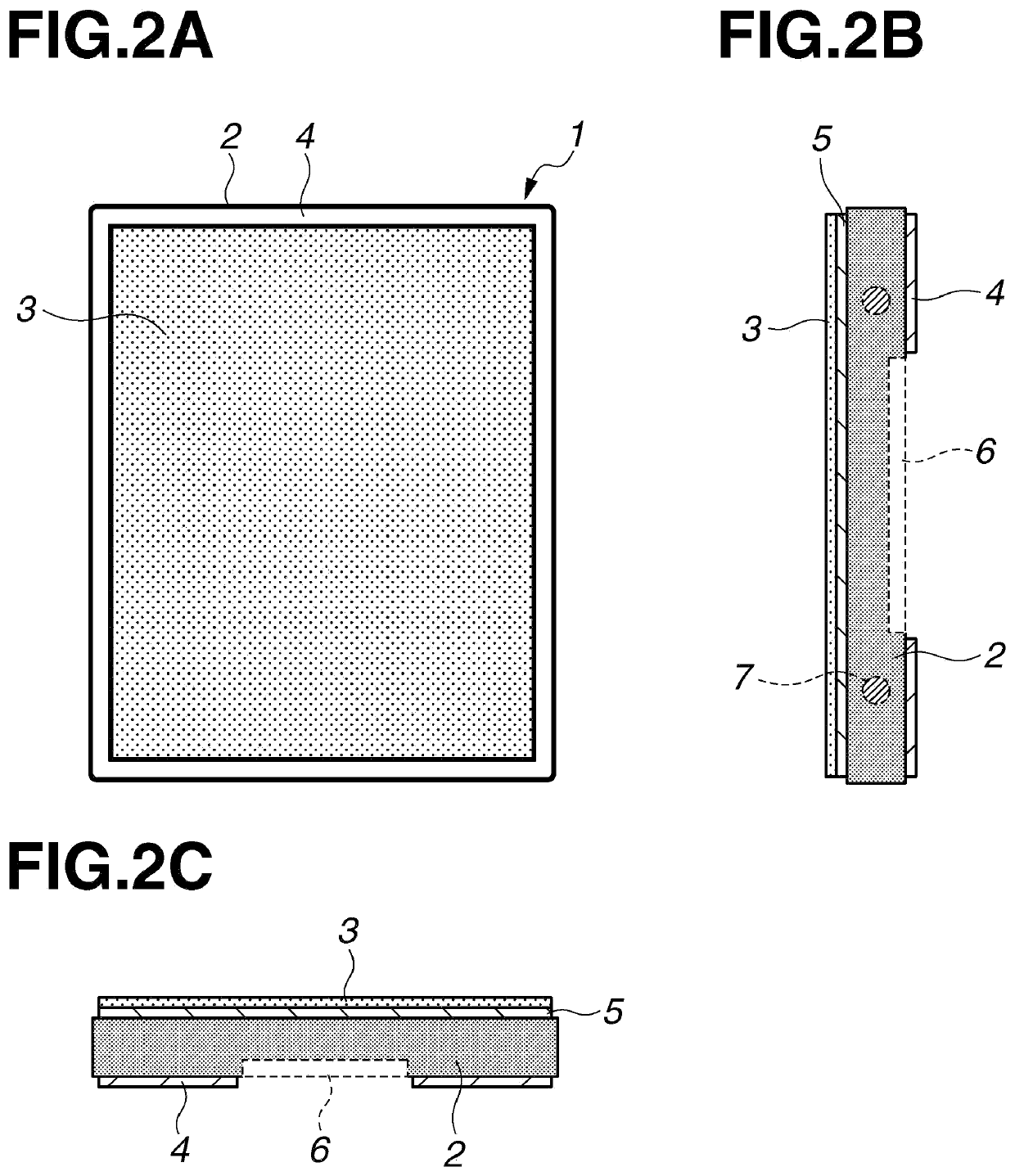Pellicle
a technology of pellicle and pellicle body, applied in the field of pellicle, can solve the problems of deformation of transfer pattern, black and dirty base, quality, appearance, etc., and achieve the effect of generating outgas from the entire pellicl
- Summary
- Abstract
- Description
- Claims
- Application Information
AI Technical Summary
Benefits of technology
Problems solved by technology
Method used
Image
Examples
example 1
[0039]A pellicle frame (having an outer size of 150×118×1.5 mm and a frame width of 4 mm) made of invar was washed. Into a silicone pressure-sensitive adhesive agent (X-40-3264 manufactured by Shin-Etsu Chemical Co., Ltd.), 0.5 part by weight of catalyst (PL-56 manufactured by Shin-Etsu Chemical Co., Ltd.) was added per 100 parts by weight of the silicone pressure-sensitive adhesive agent to prepare a silicone pressure-sensitive adhesive agent with catalyst. The prepared silicone pressure-sensitive adhesive agent with catalyst was applied onto a lower end face of the pellicle frame. Further, the silicone pressure-sensitive adhesive agent with catalyst was also applied onto an upper end face of the pellicle frame. After that, the pellicle frame was heated under the conditions of 90° C. for 12 hours to cure the silicone pressure-sensitive adhesive agent with catalyst. Subsequently, an ultrathin silicon film was press bonded as a pellicle film to the cured silicone pressure-sensitive a...
example 2
[0042]A pellicle frame (having an outer size of 150×118×1.5 mm and a frame width of 4 mm) made of invar was washed. Into an acrylic pressure-sensitive adhesive agent (SK-1495 manufactured by Soken Chemical & Engineering Co., Ltd.), 0.1 part by weight of curing agent (L-45 manufactured by Soken Chemical & Engineering Co., Ltd.) was added per 100 parts by weight of the acrylic pressure-sensitive adhesive agent to prepare an acrylic pressure-sensitive adhesive agent with curing agent. The acrylic pressure-sensitive adhesive agent with curing agent was applied onto a lower end face of the pellicle frame, and the pellicle frame was heated at 100° C. for 16 hours to cure the acrylic pressure-sensitive adhesive agent with curing agent. Subsequently, into a silicone pressure-sensitive adhesive agent (X-40-3264 manufactured by Shin-Etsu Chemical Co., Ltd.), 0.5 part by weight of catalyst (PL-56 manufactured by Shin-Etsu Chemical Co., Ltd.) was added per 100 parts by weight of the silicone pr...
example 3
[0044]A pellicle frame (having an outer size of 150×118×1.5 mm and a frame width of 4 mm) made of invar was washed. Into an acrylic pressure-sensitive adhesive agent (SK-1495 manufactured by Soken Chemical & Engineering Co., Ltd.), 0.1 part by weight of curing agent (L-45 manufactured by Soken Chemical & Engineering Co., Ltd.) was added per 100 parts by weight of the acrylic pressure-sensitive adhesive agent to prepare an acrylic pressure-sensitive adhesive agent with curing agent. The acrylic pressure-sensitive adhesive agent with curing agent was applied onto a lower end face of the pellicle frame, the applied acrylic pressure-sensitive adhesive agent with curing agent was flattened, and the flattened acrylic pressure-sensitive adhesive agent with curing agent was heated at 100° C. for 12 hours to cure the acrylic pressure-sensitive adhesive agent with curing agent. Subsequently, into a silicone pressure-sensitive adhesive agent (X-40-3264 manufactured by Shin-Etsu Chemical Co., L...
PUM
 Login to View More
Login to View More Abstract
Description
Claims
Application Information
 Login to View More
Login to View More - R&D
- Intellectual Property
- Life Sciences
- Materials
- Tech Scout
- Unparalleled Data Quality
- Higher Quality Content
- 60% Fewer Hallucinations
Browse by: Latest US Patents, China's latest patents, Technical Efficacy Thesaurus, Application Domain, Technology Topic, Popular Technical Reports.
© 2025 PatSnap. All rights reserved.Legal|Privacy policy|Modern Slavery Act Transparency Statement|Sitemap|About US| Contact US: help@patsnap.com


